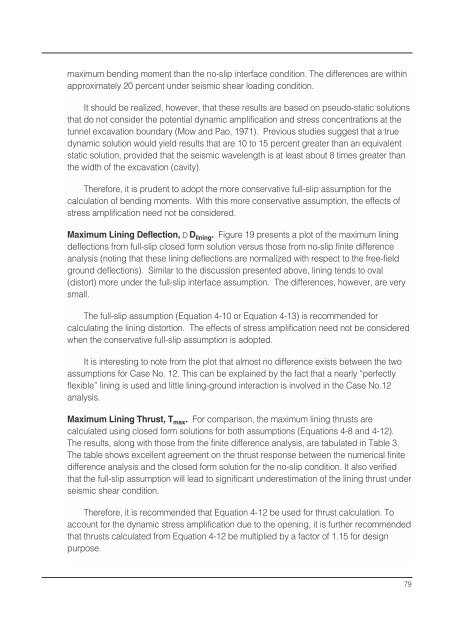Seismic Design of Tunnels - Parsons Brinckerhoff
Seismic Design of Tunnels - Parsons Brinckerhoff
Seismic Design of Tunnels - Parsons Brinckerhoff
Create successful ePaper yourself
Turn your PDF publications into a flip-book with our unique Google optimized e-Paper software.
maximum bending moment than the no-slip interface condition. The differences are within<br />
approximately 20 percent under seismic shear loading condition.<br />
It should be realized, however, that these results are based on pseudo-static solutions<br />
that do not consider the potential dynamic amplification and stress concentrations at the<br />
tunnel excavation boundary (Mow and Pao, 1971). Previous studies suggest that a true<br />
dynamic solution would yield results that are 10 to 15 percent greater than an equivalent<br />
static solution, provided that the seismic wavelength is at least about 8 times greater than<br />
the width <strong>of</strong> the excavation (cavity).<br />
Therefore, it is prudent to adopt the more conservative full-slip assumption for the<br />
calculation <strong>of</strong> bending moments. With this more conservative assumption, the effects <strong>of</strong><br />
stress amplification need not be considered.<br />
Maximum Lining Deflection, D D lining . Figure 19 presents a plot <strong>of</strong> the maximum lining<br />
deflections from full-slip closed form solution versus those from no-slip finite difference<br />
analysis (noting that these lining deflections are normalized with respect to the free-field<br />
ground deflections). Similar to the discussion presented above, lining tends to oval<br />
(distort) more under the full-slip interface assumption. The differences, however, are very<br />
small.<br />
The full-slip assumption (Equation 4-10 or Equation 4-13) is recommended for<br />
calculating the lining distortion. The effects <strong>of</strong> stress amplification need not be considered<br />
when the conservative full-slip assumption is adopted.<br />
It is interesting to note from the plot that almost no difference exists between the two<br />
assumptions for Case No. 12. This can be explained by the fact that a nearly “perfectly<br />
flexible” lining is used and little lining-ground interaction is involved in the Case No.12<br />
analysis.<br />
Maximum Lining Thrust, T max . For comparison, the maximum lining thrusts are<br />
calculated using closed form solutions for both assumptions (Equations 4-8 and 4-12).<br />
The results, along with those from the finite difference analysis, are tabulated in Table 3.<br />
The table shows excellent agreement on the thrust response between the numerical finite<br />
difference analysis and the closed form solution for the no-slip condition. It also verified<br />
that the full-slip assumption will lead to significant underestimation <strong>of</strong> the lining thrust under<br />
seismic shear condition.<br />
Therefore, it is recommended that Equation 4-12 be used for thrust calculation. To<br />
account for the dynamic stress amplification due to the opening, it is further recommended<br />
that thrusts calculated from Equation 4-12 be multiplied by a factor <strong>of</strong> 1.15 for design<br />
purpose.<br />
79
















